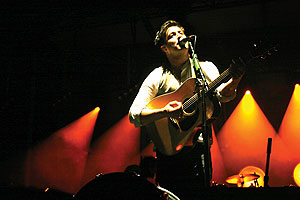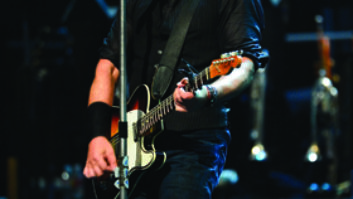
Marcus Mumford of Mumford & Sons
Photos: A.J. Nardinelli
With the exception of opening night, front-of-house engineers Chris Pollard (Mumford & Sons), Sckotch Ralston (Edward Sharpe) and Mark Richards (Old Crow Medicine Show) literally get off an old-timey train, set up FOH compound and start the show. No soundchecks. No line checks. Just 20 minutes between each act. For the 6-date Railroad Revival tour, these engineers are sharing a common board—an Avid Profile 48-channel—with scenes set for each of their bands. No outboard pieces are to be seen; the engineers rely on onboard effects—just one less thing to patch in with such a limited time frame. The majority of the gear—mics, wedges, etc.—is provided by Sound Image.
But little else is common from day to day; P.A. is hired locally. (At the Oakland, Calif., show, where Mix caught up with the start of the tour, a Martin Audio system was brought in by Delicate Productions, South San Francisco.) In addition to the Martin system, d&B J Line, L-Acoustics V-DOSC and Adamson rigs are seen on the rider.

From left: Mark Richards,
Chris Pollard and Sckotch Ralson
“Due to the nature of touring on a train and late arrivals, we have been setting up the show as if it were a festival,” says Pollard. “We load in the desk, line check and then we go straight into the gig. The first song is your soundcheck! Of course, we have the added power of using a digital desk: Each band has snapshots that allow us to control chosen parameters of channels and desk configurations. This gives us a lot of flexibility within the fixed patch. We put a lot of faith in the local P.A. providers who would set up the P.A. prior to our arrival; this experience has demonstrated just how this can make or break a gig.”
“It was a little crazy not having soundchecks, but we got lucky in that we would usually get a few minutes to line check and hear maybe one or two things before we started,” adds Richards. “For the most part, the biggest challenge was using a different P.A. most days. It was really up to the Mumford guys to check the P.A. before we got it there. I just dealt with what was handed to me, but for the most part it was pretty close to what I would do. I work with our monitor engineer, Chris Davis, to make sure it’s good on both sides of the speakers. We do a lot of work with polarity/phase and time alignment to help make that happen.”
Fortunately, both engineers are working with true musicians and professionals. The bands’ sets are tight and clean, with numerous performers onstage. Mumford & Sons’ four main members are sporadically accompanied by guest musicians. The sets are infused with a folk-rock sensibility, lending an air of inspired creativity as each band takes more of a jam and groove direction. Headliners Mumford & Sons played the majority of their hits from their recent release, Sigh No More, as well as treated fans to a few songs from their upcoming album. And if the concertgoers’ reactions are any barometer to an album’s success, we’ll be seeing Mumford & Sons accepting a Grammy next year.
Pollard says he attacks Mumford’s mix as if it were a rock gig, even though it may appear as a bluegrass show. “The instruments are compressed to give them more bite, the kick drum and bass need to be big and powerful to get the crowd going,” he says. “The vocal harmonies need to be kept in line as they are such a big part of the sound. For this, I mix down to subgroups and use a stereo reverb to achieve an added sense of space.”
Old Crow Medicine Show’s music has more of an old-timey feel, complete with fiddle, harmonica and banjo. Richards’ challenge comes in getting these instruments heard in loud situations. “Typically, our shows have really rowdy and loud crowds. I ride my VCA/DCA to bring the vocals down between verses, to keep not only the mix cleaner, but it also helps keep the front row of fans’ yelling out of the mix, too. I also use EQ and HPFs to keep things out of the instrument mics that shouldn’t be there while keeping it tonally correct for the music.” A Shure Beta 98 mikes the fiddle as he’s not a fan of the sound of fiddle pickups. The open-back banjo has an SM57 in the back. “I’ve found over the years that it’s the absolute best way to get the old-time sound,” says Richards. “Since it’s inside the back of the banjo, it keeps it isolated from the other instruments, so at loud stage volumes it’s clean.”
During each show, the engineers record their sets to Pro Tools and send those off to a mix engineer; at press time, it is unknown what will become of these mixes, but perhaps we’ll see a live CD come to market.
Sckotch Ralston Interview
How has it been with no soundcheck?
Fortunately, I’ve been touring with these guys for a while and we’ve done a lot of festivals and shows where we’ve been really pressed for time so it hasn’t been ideal, but it hasn’t really been impossible or too detrimental. We’re also on this tour squeezed in between the other two bands so we’re just “throw and go” as the middle band. But as I said, it is a little more challenging with this band, mixing in this style because there are so many of them. It’s like having two full bands onstage: Two drum kits, 10 people and they’ve usually invited someone, so it’s really 11—so you have to have someone like me who likes to fly by the seat of his pants: no set list, no idea what the first song is going to be. And just make it happen.
The way we’ve been using the console—Avid Profile—we’ve been using snapshots a lot so we can just selectively recall channels between each set. We can build on what’s been happening that particular night because each night things change a little bit. That’s partially why the digital consoles have become so popular: convenience, reliability and size. For the most part, they sound pretty good. This would have been more challenging if we were on an analog console.
How are you accommodating the numerous guests onstage?
We basically have everything on the stage; it’s pretty much live all the time. We have 48 inputs and they’re all there if they’re needed. Someone comes on, picks up something, starts wailing away, we’ll fit him in the mix.
How would you define your mixing style?
I’m using a raw style because there are so many instruments going on at any given time; it’s more of a performance on my part because I have to know what all their parts are for each song and just ride the faders from section to section for each song. Some songs the keyboards need to be featured, some songs the bass and piano have to hold the groove down, some songs the percussionist is playing the hand drums, some songs the accordion is really what adds the flavor to that section of that song—you have to know the songs, know the band. I’ve seen the songs evolve from sounding pretty close to the album to now they’re free-floating little journeys that happen differently every night. It’s been fun to see that develop over time.
I don’t use a lot of compression because I like things to poke out a little bit when someone’s playing a bit harder; it helps the dynamics. Some of the sounds are a little bit trickier to work with. We have an upright piano and the pickups are these magnetic strips that go inside and they all combine into this combiner box and it’s mono. That requires a little compression; I compress the bass and I do the compress Alex [lead vocalist] a little bit because he’s got everything from talking to screaming. I would like to use a little more compression on the vocals. I’ve got nine open vocals mics so I can’t really use much compression.
There are a lot of instruments and musicians onstage. How are you keeping your mix clean?
It’s a challenge to get the mix across and that ties into knowing the songs. With nine vocal mics, I have to know who is singing when and when they’re not singing I try to keep their fader down because they’re usually standing near a drum kit.
I’m carving out little frequency niches for each instrument. If you think of the audio spectrum in a visual sense, you’ve got a canvas to work with. I like to try to make instruments a little peak-y, maybe a little bit more so than I would do in a recording studio and certain frequency ranges just so they have their own space in the stereo spectrum. There’s definitely some overlap that can’t be avoided, but using a combination of panning and EQ, mostly, I’m able to squeeze all the people into two speakers.
It’s been a pleasure working with Chris and Mark; both of those guys are outstanding engineers. What an experience that tour was!





